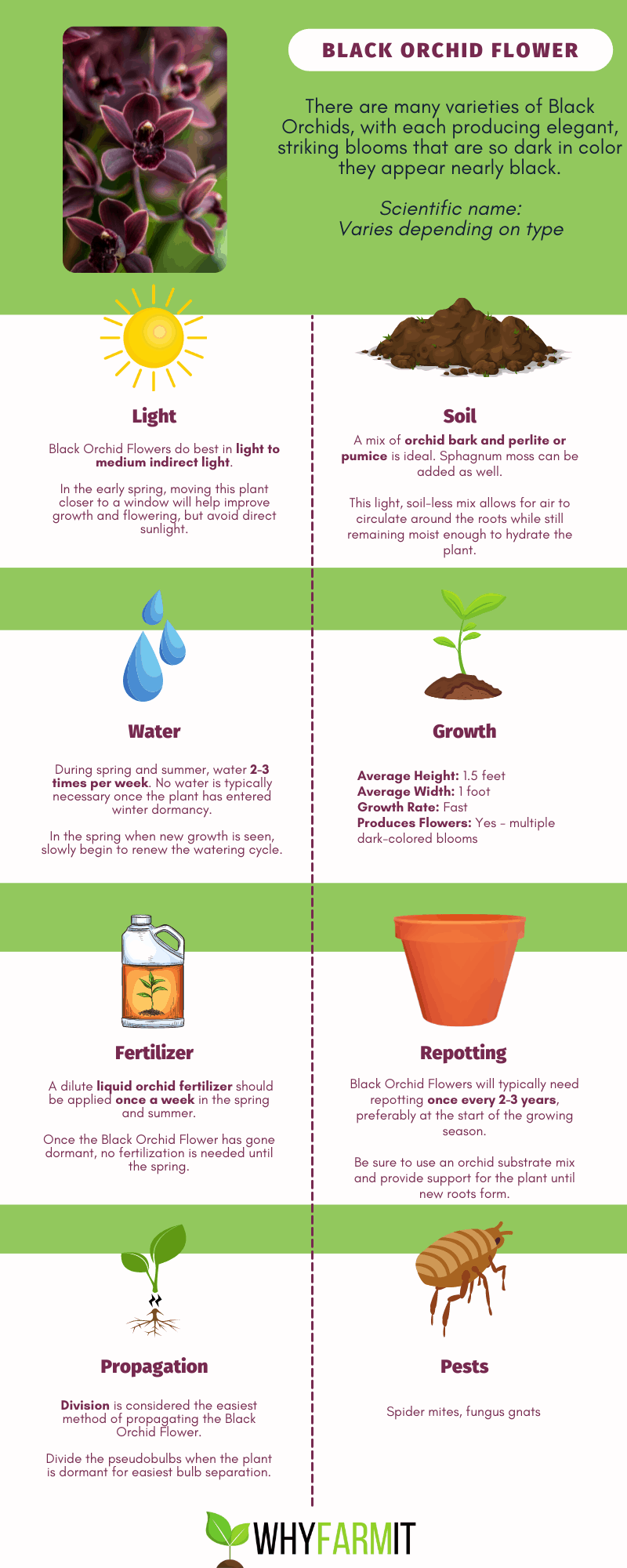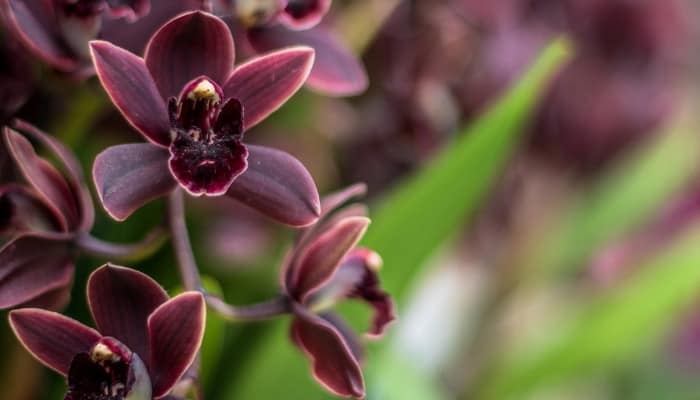The black orchid flower is a plant that is sure to catch the attention of your visitors. Many individuals are unfamiliar with black flowers, especially ones as visually stunning and unusual as those seen on an orchid.
There is an air of mystery around the dark petals, and legends even tell of ancient witches using black petals for their magic.
How do you care for a black orchid flower? Black orchids will do best when potted in a mix of orchid bark, perlite, and sphagnum moss. They thrive in indirect light, 65-85℉ temperatures and 60-80% humidity. In the growing season, water 2-3 times per week and fertilize with a diluted orchid food weekly. When dormant, don’t water or fertilize.
Complete Care Guide for Black Orchids
You may be wondering if these black orchids are truly black.
Some enthusiasts claim to have hybridized pure black varieties of orchid, but a majority of the black orchid flowers on the market are very dark red or violet flowers.
However, that doesn’t mean that they are any less beautiful.
Complete Care Guide for Black Orchids
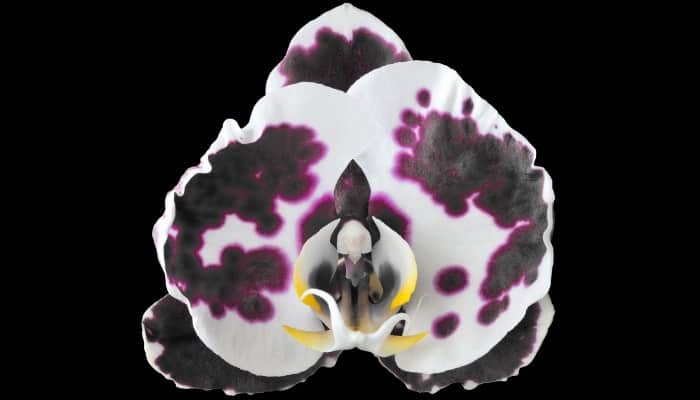
The name “black orchid” is a common name used for a number of different orchid species and hybrids.
Most of the plants sold at garden centers and supermarkets are these hybrid varieties. Regardless of their origin, most orchids require similar care.
Black Orchid Flower at a Glance
- Plant Type: Tropical epiphyte
- Scientific Name: multiple species, each with different name
- Average Height: 1.5 feet
- Average Width: 1 foot
- Growth Rate: Fast
- Produces Flowers: Yes
- Common Pests: Spider Mites, fungus gnats
- Life Expectancy: Decades
- Difficulty of Care: Medium
What To Do When You First Get Your Black Orchid Flower
When you first get your black orchid flower, it is important to check the substrate and container, especially if you purchased your orchid from a supermarket or garden center.
Many times, these orchids are planted in soil and placed in a pot without drainage.
If necessary, repot your orchid with the correct substrate and a pot with a drainage hole or specific orchid container.
However, if your plant has blooms, hold off on changing the substrate until the flowering season is over.
Ideal Soil for Black Orchid
Orchids are epiphytes, meaning they grow on trees. They are not parasitic and merely use the tree to support the roots and plant.
This means that a true soil is the incorrect medium for a black orchid flower.
The ideal planting medium for this plant is orchid bark with a small amount of pumice or perlite.
This combination leaves ample room for airflow around the roots, but it will also hold enough moisture to keep the plant healthy.
Some people will also include sphagnum moss or packing peanuts in their orchid planting mediums.
Black Orchid Flower Water Requirements
During the growing season (spring and summer) the black orchid flower needs moderate water, which can mean replenishing 2 or 3 times per week.
After the winter dormancy, you should not begin watering your orchid until two weeks after new growth has started forming.
Orchids have pseudobulbs that hold water and nutrients for use during the dormant phase and the beginning of the growing phase.
Watering too soon can lead to root rot, as the roots are not yet ready to start absorbing the moisture.
In the fall, the leaves on the orchid will start to yellow and drop off. This is your sign to slow down watering.
Once a majority or all of the leaves have died, you can stop watering all together for the dormant winter season.
If you live in an especially dry climate, your black orchid flower may require one or two waterings during the entire dormancy.
Black Orchid Lighting Needs
Black orchid flowers can survive in a variety of lighting situations. However, you should always avoid direct sunlight, which can burn the leaves and flowers.
Low to medium indirect light is the best lighting situation for the plant.
Depending on the plant’s location, it may need to be moved closer to a window at the beginning of the growing season.
While still only allowing indirect light, brighter sunlight will help promote growth and blooming.
Ideal Temperature Range for Black Orchids
Black orchid flowers are tropical plants that prefer warm temperatures for most of the year. A range of 65-85℉ is ideal.
Some species of black orchid flower will benefit from cooler nighttime and winter temperatures.
These temperature swings help the plant to know when to go dormant, when to begin growing again, and when to bloom.
Ideal Humidity Level for Black Orchid Flowers
Since wild orchids do not grow in soil, and therefore do not obtain most of their moisture from the substrate, humidity is important for the health of the plant.
The roots and leaves of the black orchid flower will absorb moisture through the air. An ideal humidity level is 60-80%.
To maintain such high humidity, black orchid flowers do well when placed over a pebble tray. These trays have pebbles, LECA balls, or pumice in a saucer.
Water is placed in the saucer but below the top of the pebbles. The water evaporates and increases the humidity around the orchid.
These trays are not only good for orchids but also for any humidity-loving plant, and they come with decorative white pebbles ready to use.
Best Location for Black Orchid Flower
Your black orchid flower will do best in a bright room that does not receive direct sunlight. A north-facing window is optimal.
The plant should be placed in a location where there are no drafts but still plenty of airflow around the plant.
Black Orchid Growth Habits
Black orchid flowers grow quickly and produce flowers during the spring and summer.
Come fall, the flowers and leaves will die off as the plant transitions into dormancy for the winter.
Fertilization Type & Schedule for Black Orchid Flowers
During the growing season, the best fertilization schedule is to supplement the plant weekly with a diluted fertilizer.
It is important to use a fertilizer that is specially formulated for orchids.
Most of these fertilizers contain plenty of potassium and phosphorus; both of which promote healthy and beautiful blooms.
Once the leaves of the black orchid flower start to turn yellow in the fall, stop fertilizing until the following growing season.
Signs of Nutrient Deficiency
- Calcium deficiency – black tips on leaves, edges of the leaves yellow, new buds die before growing
- Magnesium deficiency – yellowing and mottled coloration on leaves
- Nitrogen deficiency – mottled yellowing of older leaves, leaf edges curl inward
- Potassium deficiency – older leaves die off at the tip
Pruning Black Orchid Flower
In most cases pruning is not necessary for the black orchid flower.
If leaves have died due to pests or other issues, they should be removed so the plant will focus nutrients on healthy plant tissue.
When the orchid goes into dormancy in the winter, most or all of the leaves will die and drop off the plant. New leaves will begin to grow in the spring.
Does a Black Orchid Produce Flowers?
Yes, all black orchids produce flowers. Since there are multiple species that use the common name “black orchid,” there are different variations of flowers.
Almost all of the flowers have red or violet petals that are so dark that they appear black.
Is Black Orchid Flower Toxic?
The black orchid flower is nontoxic to pets and children.
Black Orchid Flower Propagation
The least intrusive and easiest way to propagate black orchid flowers is by dividing the pseudobulbs.
This can be done when the pseudobulbs are active and have stems and leaves.
Division is even easier when the plant is dormant as the pseudobulbs are easy to separate and replant before the growing season.
Division should never be done while the orchid is flowering, though.
1. Determine If a Plant Is Large Enough To Divide
Depending on the age and size of your black orchid plant, it can have one or many pseudobulbs. At least two pseudobulbs are needed to divide the plant.
2. Carefully Separate Pseudobulbs
If the plant is active, carefully separate the pseudobulbs by cutting them if necessary. It is best to make sure that each new plant has plenty of healthy roots.
Dormant pseudobulbs can be gently pulled away from one another.
3. Plant Separated Pseudobulbs
Active orchids should be planted in a similar set-up to the original container and potting mixture.
Dormant orchids have a little more leeway since they will not grow again until spring.
4. Maintain Moisture and Humidity
For active plants, maintain moist substrate and high humidity to help the plant adjust to its new surroundings.
If the plant is small enough, it may benefit from a clear bag over the container, creating a humid greenhouse effect.
Dormant plants can be left as is until the growing season begins. Begin watering once roots are 3 to 5 inches long.
Repotting Black Orchid Flower
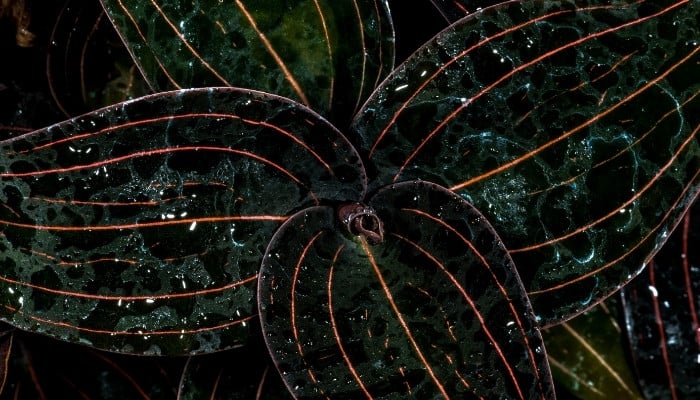
Like many houseplants, black orchid flowers prefer to be fairly pot bound.
In the case of the orchid, the epiphytic roots do best when they are not surrounded by excessive substrate.
When To Repot Black Orchid Flower
Most orchid growers will agree that your plant should be repotted every couple of years.
While the plant and some roots will die back during the dormant period, the plant will continue to get larger if it is receiving everything it needs.
Another sign that the orchid is ready to be repotted is if the roots are spilling out of the container. Also, the stems may become too long and heavy for the small container.
Try to repot your black orchid flower just before or at the beginning of the growing season.
If you repot once your orchid has bloomed, you risk the plant dropping the flowers from the stress of repotting.
Signs That It’s Time To Repot
- 2 years since last repotting
- Roots are spilling out of container
- Stems are too top-heavy, and the container is tipping over
How to Repot Black Orchid Flower
Before you begin repotting your orchid, it is important to choose the right container. Many enthusiasts use clear or ceramic orchid pots that have holes cut out on the sides.
This allows plenty of airflow around the roots and makes it easy to check root health and substrate moisture.
Since excess substrate can hold too much moisture and attract pests, it is recommended to only go up one container size when repotting.
1. Take Plant Out of Container and Remove Soil
When repotting your black orchid flower, begin by carefully removing your plant from the container and gently shaking off the substrate from the roots.
2. Place Plant in New Pot and Fill in With Orchid Mix
Place as many roots as will fit into the new container. Loosely fill in the space around the roots with an orchid substrate mix.
3. Provide Support for the Plant
It may take a little while for the roots to become established in the new container, so top-heavy stems should be supported with a pole and clips.
Black Orchid Common Problems & Solutions That Work
Black Orchid Flower Common Pests
Since black orchid flowers are not planted in a traditional substrate, they are partially protected against many common pests.
However, the high humidity and moisture that they require can attract some pests, such as fungus gnats.
Spider Mites
Signs of Trouble
Spider mites can be hard to spot due to their incredibly small size. For most cases, the first sign of infestation is thin webbing seen on the plant.
In addition, the underside of the leaves, where the spider mites feed, can have a shine due to the loss of sap.
Solution
Gently rinse off your orchid to remove webbing and as many spider mites as possible. It is also important to isolate the infested plant to prevent the mites from spreading.
Treat your black orchid flower with diluted soapy water every few days for three weeks.
Prevention
Spider mites like warm, dry environments. Keeping high humidity around your orchid and moving it away from a warm windowsill can help prevent future infestations.
Fungus Gnats
Signs of Trouble
Small, black flies can be erratically flying around the plant.
Solution
Allow the substrate to dry out. Fungus gnat larvae can only survive in moist conditions. Place sticky traps around the plant to catch adult flies.
If needed, insecticide or neem oil (try this organic neem)can be used to treat the substrate.
Prevention
Allow your substrate to dry out as much as possible between waterings without affecting the health of the plant.
Mosquito larvae prevention (typically used in outdoor ponds) can be added when watering to eliminate any larvae in the substrate.
Black Orchid Flower Common Diseases
Black orchid flowers are susceptible to many fungal and bacterial infections. Once present, these infections can spread rapidly due to the high humidity around the plant.
Root Rot
Root rot is a fungal infection that typically occurs when there is too much moisture in the substrate.
Signs of Trouble
If your black orchid flower is planted in a clear container, you will see the roots turning dark brown and dying. The plant may start to wither and drop leaves or flowers.
Solution
Water as little as possible while the plant is under treatment. Remove all affected parts of the orchid and discard.
Treat the remaining parts of the plant with a fungicide (try this organic copper fungicide). You can also disinfect the container and replace the substrate.
Prevention
Never overwater your black orchid flower. The substrate should be light and airy, composed mainly of bark instead of soil.
An orchid container with plenty of drainage and air holes will maintain proper substrate conditions.
Soft Rot
Soft rot is a bacterial infection that can affect any part of the orchid.
Signs of Trouble
Spots that look like the plant is soaked in water will begin to appear on leaves or stems. These spots will rapidly grow into large soft patches of rotten tissue.
Solution
Remove all affected tissue and treat with an antibacterial plant treatment. You can also use hydrogen peroxide to disinfect the plant and the substrate.
Prevention
Bottom water your orchid to prevent water from splashing onto the leaves and sitting for an extended period. Make sure that the plant has ample airflow around it.
Other Common Problems
Any other problems with your black orchid flower are most likely caused by incorrect care conditions.
Bud Blast
Bud blast is a condition when new buds will dry up and die with no obvious reason.
Signs of Trouble
New buds are drying up and dying. There may also be yellowing, wilting, or curling seen in the leaves.
Solution
Assess your care routine, and make sure all of your plants needs are being met.
Black orchid flowers should have high humidity, no direct light, moderate watering, and light fertilization.
Prevention
Maintain appropriate care of your black orchid plant, especially in the early growing season.
Black Orchid Common Questions
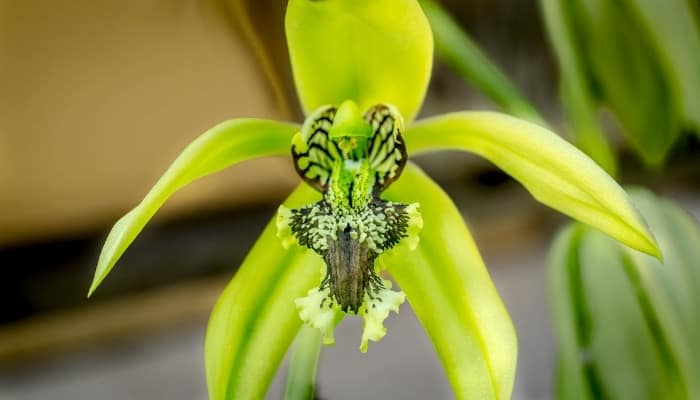
Are Black Orchids Rare?
Orchid hobbyists have been trying for years to create a true black orchid.
Therefore, many varieties of black orchids (the flowers are actually very dark red or violet) are available on the market.
Are Black Orchids Really Black?
True black flowers are extremely rare in nature. The black orchid flowers available today are all dark red or violet in color.
When contrasted with the green plant, these flowers appear to be black.
How Do You Tell If an Orchid Has Been Dyed?
You can check the plant to see if there is an injection hole in the stem or if there is dye visible in the roots.
If that proves inconclusive, you may have to wait until the plant re-blooms the following year. The next set of blooms will be in the plant’s original color.
Are Black Orchids Bad Luck?
Some believe that the black orchid flower is a symbol for bad luck.
What Do Black Orchids Symbolize?
Depending on who you ask, the black orchid flower can symbolize a variety of things:
- Strength
- Virility
- Success
- Dark magic
- Bad luck
What Colors Do Orchids Come in Naturally?
Orchids can come in every color except blue and true black.
What Time of Year Do Orchids Bloom?
Orchids will bloom in the spring and summer. The blooms can last for many months.
How Do I Get My Black Orchid To Bloom All Year?
Once the blooms fall off, you have to create conditions that trick the plant into skipping dormancy and blooming again.
To do this, make sure you are continuing to water and fertilize the plant regularly.
Set up your black orchid flower so it receives a temperature swing of at least 10 degrees between daytime and nighttime.
How Long Do Black Orchids Live?
Black orchids can live many years with proper care. There are some orchids reported to be over 100 years old!
Why Are the Leaves on My Black Orchid Turning Black?
There are a few reasons why the leaves on your black orchid flower could be turning black:
- Over-fertilization
- Hard water
- Bacterial or fungal growth
What’s the Best Fungicide for Orchids?
There are a number of fungicides available on the market that can work for orchids. Choose a copper or peroxide based fungicide that is formulated for orchids.
Is Baking Soda Good for Orchids?
Baking soda can be beneficial for orchids when used appropriately. Baking soda is mixed into water and sprayed onto the plant as a natural treatment for many diseases.
3 Key Tips for Success With Black Orchid Flower
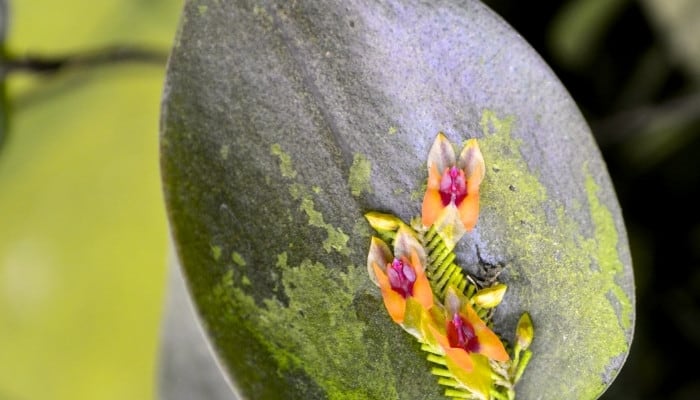
1. Choose the Correct Substrate
Your black orchid flower will not enjoy being in soil. Choose an airy substrate mix that is mainly bark and sphagnum moss.
2. Allow a Dormant Phase
While it may not be as beautiful, it is natural for the black orchid flower to drop its flowers and leaves to go into a winter dormancy. This is part of the life cycle of the plant.
3. Never Over-Fertilize
Since wild orchids grow on trees, they only receive small amounts of nutrients as they trickle down the trees. They are not adapted to absorb large quantities of nutrients.
Conclusion
Orchid care is different from most house plants, but it does not have to be hard.
Once you understand the needs of this exotic plant, you can enjoy any variety of orchid, especially the black orchid flower.
